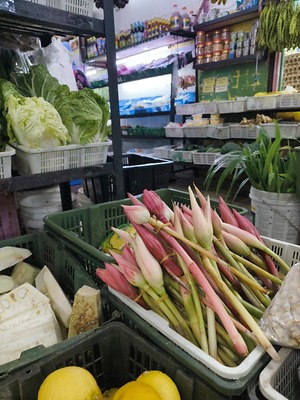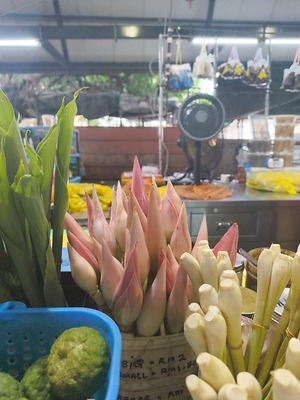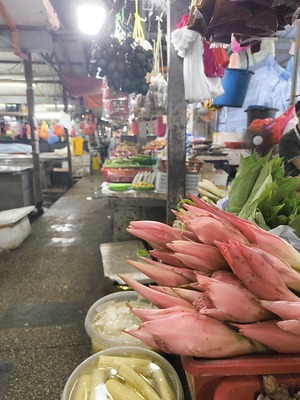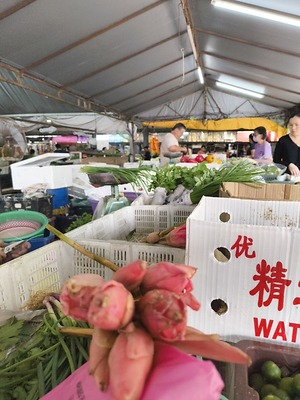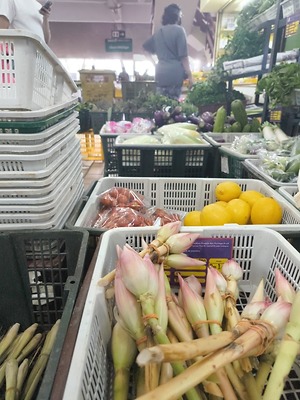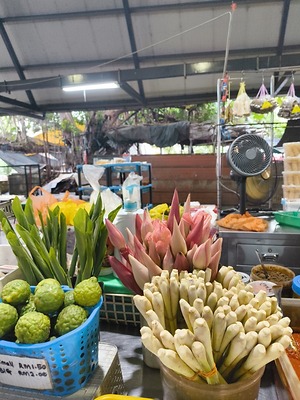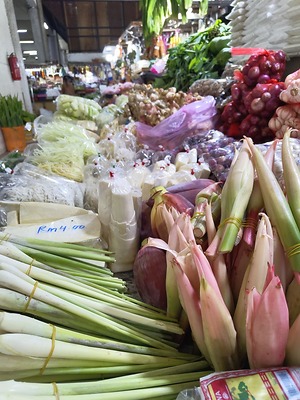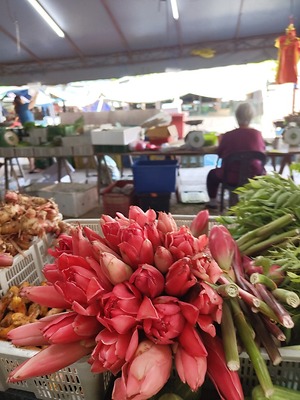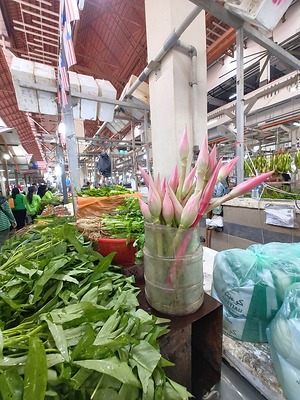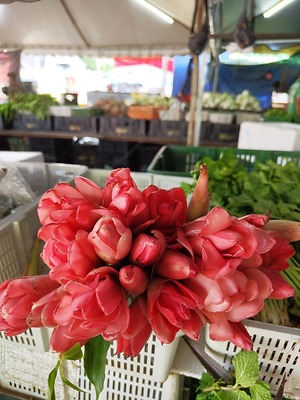

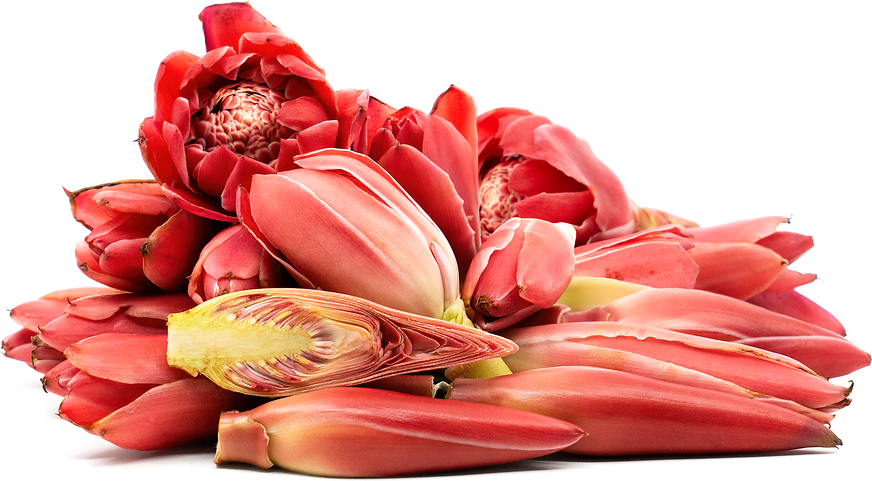
Torch Ginger Flowers
Estimated Inventory, lb : 0
Description/Taste
Torch Ginger flowers are comprised of elongated, tapered buds on top of tall stalks stabilized by underground rhizomes. The green, fleshy stalks are thick and fibrous, reaching up to one meter in height, and grow upright in a stiff, straight formation. At the top of the stalks, the buds have a teardrop to oval shape, averaging ten centimeters in length, and are comprised of oval and waxy, petal-like layers known as bracts, protective, modified leaf coverings that encase the developing petals. When young, Torch Ginger flowers are tightly closed, forming a flame-like shape, and range in color from pink, red, to white. As the flower blooms, the bracts will open, revealing small colorful flower petals. Torch Ginger flowers are consumed when the buds are somewhat closed and have a crisp, succulent, and lightweight texture. The aromatic bracts also emit a sweet, floral, and subtly ginger-like scent and have a sweet and sour, piquant flavor with citrus-forward nuances.
Seasons/Availability
Torch Ginger flowers are available year-round in tropical climates, with a peak season in the late spring through early summer.
Current Facts
Torch Ginger flowers, botanically classified as Etlingera elatior, are tropical plants native to Southeast Asia belonging to the Zingiberaceae or ginger family. The brightly colored blooms have been utilized in ornamental, medicinal, and culinary preparations for centuries and are highly favored for their zesty, ginger-like flavoring. There are three main colors of Torch Ginger flowers, found in pink, red, and white shades, and the pink blooms are considered the most common in fresh markets. Torch Ginger flowers earned their name from their elongated stem and curved tapered flower, similar in appearance to a flaming torch, and are known by many regional names, including Wax Flowers, Ginger Flowers, Torch Lilies, Indonesian Tall Ginger, Wild Ginger, Rojak Flowers, and Porcelain Rose. In the modern-day, Torch Ginger flowers are widely incorporated as a staple flavoring in Southeast Asian dishes, and the entire plant, including the seeds, flowers, and leaves, are edible. Torch Ginger plants are also one of the most commercialized tropical flower varieties for decorative flower arrangements and backyard landscapes.
Nutritional Value
Torch Ginger flowers are a good source of fiber to stimulate the digestive tract and contain antibacterial and anti-inflammatory properties to boost the immune system. The buds also provide antioxidants such as vitamin C to protect the body against external aggressors and have some magnesium to regulate nerve functioning, vitamin K to assist in faster wound healing, and calcium to build strong bones and teeth.
Applications
Torch Ginger flowers have a piquant, ginger-like flavor well suited for fresh and cooked preparations. The flowers are typically thinly sliced and added just before serving and are utilized as a garnish or flavoring. The flowers can be thinly sliced and tossed into salads, shredded and blended into dips and sauces, or used whole as a food wrap. Torch Ginger flowers are also traditionally incorporated into seafood dishes, believed to help mask fishy odors or stirred into stews, soups, curries, rice, and noodle dishes. In Singapore, Torch Ginger flowers are chopped and mixed into rojak, a spicy fruit and vegetable salad that is a typical side dish for everyday meals. Beyond traditional uses, Torch Ginger flowers are being used in modern, unconventional applications to showcase the bud’s sour flavor, specifically in dishes such as sorbets and ice cream. The flowers are also being infused into cocktails, and essential oils are extracted from the buds as an ingredient for tea. Torch Ginger flowers pair well with spices such as turmeric, coriander, chile powder, and curry powder, aromatics including lemongrass, galangal, and garlic, seafood, meats such as beef, poultry, or smoked duck, cucumber, bell peppers, and fruits including mango, coconut, pineapple, and citrus. The flowers should be used immediately for the best quality and flavor. Whole, unwashed Torch Ginger flowers will keep up to one week when wrapped in paper towels and stored in the refrigerator's crisper drawer. The flowers can also be frozen or dried for extended use.
Ethnic/Cultural Info
Torch Ginger flowers are known as Bunga Kantan in Malaysia and are one of the signature elements of Nyonya cooking, a unique blend of Southeast Asian, Chinese, and Malay traditions. Nyonya cuisine has been an established cooking style since the 15th century when Chinese immigrants moved to Indonesia, Malaysia, and Singapore for a better way of life. Traditional Chinese cooking techniques were blended with tropical Southeast Asian ingredients, creating dishes with complex flavorings, textures, and aromas. Torch Ginger flowers have a citrus-forward flavor used to mask sour, fishy notes in seafood dishes. The flowers are highly prized for their zesty taste and are commonly found in fresh markets or foraged from wild plants in the jungles surrounding the villages and settlements. Torch Ginger flowers are used in Nyonya cuisine as an everyday flavoring, prized for their crisp consistency and sharp, zesty flavor. Dishes associated with Nyonya cuisine traditionally have aromatic, tangy, salty, spicy, and sweet qualities, and one of the most famous Nyonya dishes is assam laksa, a pungent fish stew. Assam laksa is frequently associated with the area of Penang and is a spicy, sour noodle dish comprised of fish, aromatics, Torch Ginger flowers, chile peppers, cucumbers, calamansi, and shallots. Torch Ginger flowers are also sliced thin and tossed into kerabu or are mixed with fresh herbs in nasi ulam, a famous rice dish.
Geography/History
Torch Ginger flowers are native to tropical regions of Malaysia, Indonesia, and Southern Thailand and have been growing wild since ancient times. The plants are easily propagated and were quickly spread throughout Southeast Asia, China, Oceania, and Australia. Torch Ginger flowers were also introduced to Hawaii, Florida, and South America as a cultivated tropical species and are used for ornamental landscaping. Today Torch Ginger flowers can be found worldwide, both cultivated and wild, and are present in Asia, Australia, Oceania, Polynesia, Africa, South America, Central America, and in Florida, California, and Hawaii of the United States. In Costa Rica, Puerto Rico, Hawaii, and China, the species has also been deemed an aggressive invasive species. When in season, the Torch Ginger flower buds can be found through specialty growers or fresh local markets.
Recipe Ideas
Recipes that include Torch Ginger Flowers. One



